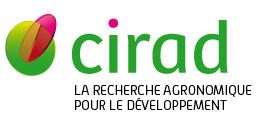Analysis of genome-wide linkage disequilibrium in the highly polyploid sugarcane
Raboin L.M., Pauquet J., Butterfield M., D'Hont A., Glaszmann J.C.. 2008. Theoretical and Applied Genetics, 116 (5) : p. 701-714.
Linkage disequilibrium (LD) in crops, established by domestication and early breeding, can be a valuable basis for mapping the genome. We undertook an assessment of LD in sugarcane (Saccharum spp), characterized by one of the most complex crop genomes, with its high ploidy level (?8) and chromosome number (>100) as well as its interspecific origin. Using AFLP markers, we surveyed 1,537 polymorphisms among 72 modern sugarcane cultivars. We exploited information from available genetic maps to determine a relevant statistical threshold that discriminates marker associations due to linkage from other associations. LD is very common among closely linked markers and steadily decreases within a 0ô¢30 cM window. Many instances of linked markers cannot be recognized due to the confounding effect of polyploidy. However, LD within a sample of cultivars appears as efficient as linkage analysis within a controlled progeny in terms of assigning markers to cosegregation groups. Saturating the genome coverage remains a challenge, but applying LD-based mapping within breeding programs will considerably speed up the localization of genes controlling important traits by making use of phenotypic information produced in the course of selection.
Mots-clûˋs : saccharum; gûˋnome; polyploû₤die; marqueur gûˋnûˋtique; polymorphisme gûˋnûˋtique; variûˋtûˋ; gû´ne; identification; liaison gûˋnûˋtique; linkage disequilibrium; gû´ne d'intûˋrûˆt; aflp; cultivar
Documents associûˋs
Article (a-revue û facteur d'impact)
Agents Cirad, auteurs de cette publication :
- D'Hont Angûˋlique — Bios / UMR AGAP
- Glaszmann Jean-Christophe — Bios / UMR AGAP
- Raboin Louis-Marie — Persyst / UPR AIDA
